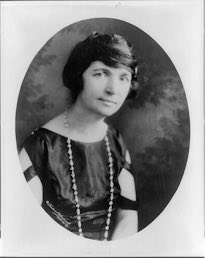Margaret Higgins learned from her nonconformist father to be a rebel and to reject prejudice.
She married William Sanger, an architect, but after three children and ten years in an affluent Westchester suburb, she yearned for more. The Sangers moved to New York City and plunged into the world of bohemian radicalism in Greenwich Village.
Perhaps the radical activist Emma Goldman first introduced her to the issue of birth control. Margaret Sanger worked as a visiting nurse on the Lower East Side. She always said that a poor woman named Sadie Sachs, dying after trying to end an unwanted pregnancy, made her determined to take up the fight.
Sanger published The Women Rebel, a newspaper advocating birth control, and when indicted for sending “obscene” materials through the mails, she fled to Europe and gathered information there.
In 1916 she opened a clinic in Brooklyn, was arrested, and served thirty days for distributing information about contraceptives. From then on, Sanger assumed leadership of the struggle for free access to birth control. She was persuasive, diligent, and unafraid of a fight. Her arguments might vary – at first she saw birth control as part of a socialist reordering of society, later as a means to prevent the multiplication of the inflicted or to assure happy marriages. But always Sanger saw it as a woman’s issue and she was prepared to take on the medical establishment, the churches, the legislatures, and the courts.

